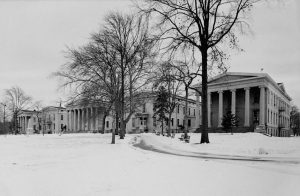The best examples of the Greek Revival Style in New York City, if not in the US, are not a great residence or bank. Located on the north shore of Staten Island today, overlooking Richmond Terrace, Snug Harbor was designed to serve as a rest home for, quote “aged, decrepit and worn out seamen” (SLIDE). The trust to support Snug Harbor was established in 1801 when Captain Robert Richard Randall, Revolutionary War soldier and ship master left a large estate north of Washington Square Park to support Snug Harbor.
Five buildings, named A through E, were erected between 1831 and 1833 and were designed in the Greek Revivalist style. With the exception of Building C all of these buildings were dormitories, where the retired sailors lived. The imposing, varied and elegant façades aggrandized what would have otherwise been simple dorms. Building C was the centerpiece of the complex.This magnificent structure, with its monumental Ionic portico, was constructed of Westchester marble. It originally housed all the institution’s functions except for cooking. The interior was composed of two floors. The rectangular hall, second-floor gallery dome were redecorated in 1884 with stained glass, murals and other painted details in the neo-Classical style, appear like the frescos that we see in Roman domes but with anchors, an allusion to the profession of the retirees.
The six buildings create a striking group that balances individuality, but together form a powerful composition. The use of forms speaks to how patrons and architect built buildings that were utilitarian in nature. These buildings which today would been quite simple with low ceilings and a likely staid exterior appearance, are instead given prominence through their elegant facades. These facades reflect the fact that these buildings were civically minded architecture that reflect a communal good. Therefore such buildings should be well-built and imposing in the landscape. At the same time, the use only of a greek temple façade meant that the interior of the building could serve the needs for which it was design.


